Effective Strategies to Deter Squirrels from Your Yard
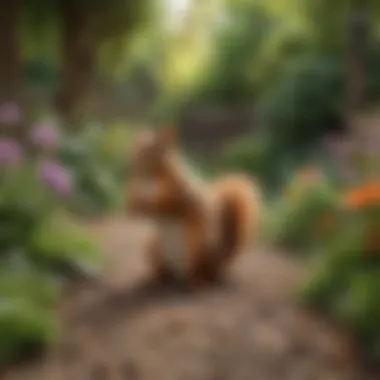
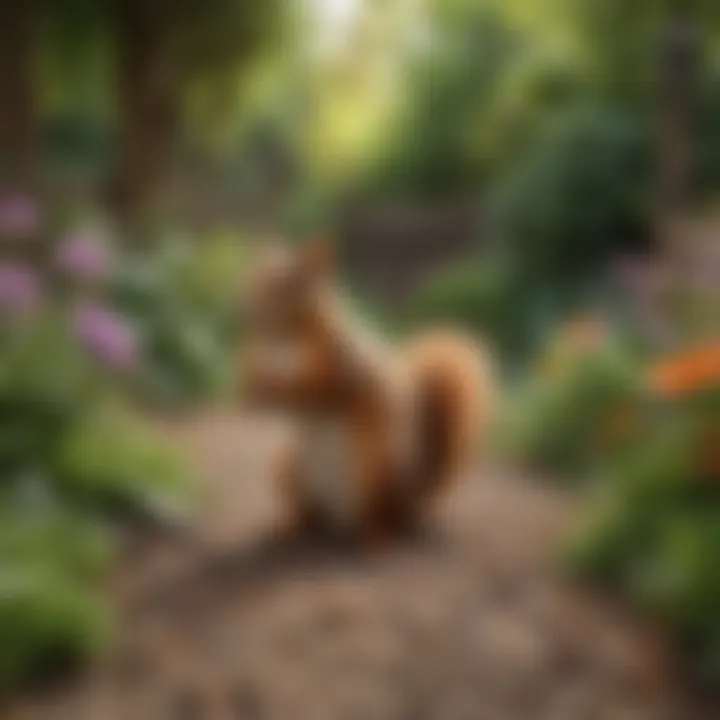
Intro
Squirrels can be a frustrating presence in your yard. Their agile movements and persistent foraging disrupt not merely the tranquility of outdoor spaces but also undermine efforts to cultivate a thriving garden. Understanding squirrel behavior is essential as a first step toward effective deterrence. These creatures are motivated by food, nesting needs, and curiosity. Thus, homeowners should adopt strategies aimed at addressing these needs while employing humane methods.
The following sections delve into practical solutions that are eco-friendly and promote a serene outdoor experience. By utilizing this knowledge, property owners can diminish squirrel activity and preserve their landscaping without causing harm. It is pivotal to employ a blend of preventive measures, behavioral modifications, and environmental adjustments.
Next, we will explore design inspirations for yards that minimize squirrel appeal while enhancing the natural beauty of your outdoor spaces.
Design Inspiration
Trending Styles
Creating an environment that discourages squirrels relies upon understanding their preferences. Landscapes that are cluttered or abundant in food sources attract these animals. Hence, a clean, minimalistic design can be an effective strategy. This approach includes:
- Utilizing gravel paths instead of mulch, which squirrels prefer for hiding.
- Choosing native plants that naturally deter squirrels, like strong-scented herbs or prickly varieties.
- Implementing raised garden beds to minimize access to roots and produce.
Incorporating physical barriers can also enhance your yard's aesthetic while serving a dual purpose. For instance, various fencing styles are available:
- Wooden picket fences offer charm and can be designed to deter access.
- Wire mesh fences are practical and can integrate well with garden designs.
These designs not only serve a functional goal but can also create visual appeal throughout your space.
Color Palettes
Engaging colors can further deter squirrels, particularly when combined with unpleasant scents. Consider:
- Earth tones may help your planting scheme to blend in with the natural texture of the environment, reducing the likelihood of attracting attention from squirrels.
- Bright, unusual colors in garden decor can be distracting. These can veil your efforts to provide food for pollinators or other wildlife away from more appealing areas.
By employing these strategies, one creates an aesthetic environment that discourages squirrel intrusion.
Practical Tips
Maintenance & Care
Regular maintenance is vital in keeping your garden less appealing to squirrels. Here are some strategies:
- Regularly remove fallen fruit or nuts that may otherwise attract squirrels to your yard.
- Ensure that bird feeders are squirrel-proof and positioned well away from trees or roofs.
- Keep compost piles securely contained, as these can be treasure troves for squirrels.
A well-maintained yard demonstrates care and can naturally deter squirrels as they seek out neglected spaces.
Budgeting & Planning
Deterring squirrels doesn't have to be an expensive endeavor. Here are budget-friendly strategies:
- Focus on DIY solutions where possible. Building your own squirrel-proof barriers or devices can be both economically sensible and satisfying.
- Research affordable native plants that deter squirrels, as they often require less maintenance and water.
Additionally, consider planning your yard changes systematically. Start with a focus on areas where squirrel activity is most pronounced, gradually optimizing the entire space for squirrel deterrence.
Following these methods provides a comprehensive approach to maintaining an aesthetically pleasing yard while effectively diminishing squirrel activity.
Understanding Squirrel Behavior
Understanding the behavior of squirrels is crucial for homeowners seeking effective strategies to deter them from their yards. Squirrels are inherently curious and bold creatures. Their habits can lead to a range of issues for gardeners and property owners alike. By recognizing their tendencies and needs, one can devise better methods to keep them at bay.
Squirrels belong to the family Sciuridae. This family includes various species, all of which display particular behaviors that make them successful in finding food and shelter. The information about these behaviors helps inform the methods used to limit their presence in residential areas.
Species Overview
In North America, there are several squirrel species, including the Eastern gray squirrel, American red squirrel, and Fox squirrel. Understanding which species inhabit your area allows for targeted deterrent strategies.
- Eastern Gray Squirrel: Commonly found in urban and suburban environments, this species is adaptable and notorious for raiding bird feeders.
- American Red Squirrel: Generally found in coniferous forests, this species tends to be more aggressive regarding its territory.
- Fox Squirrel: Larger than others, the Fox squirrel prefers open woodlands and may cause damage to trees and gardens.
Feeding Habits
Squirrels are opportunistic feeders. Their diet mainly includes nuts, seeds, fruits, and occasionally insects. They are known to cache food for winter, often forgetting the locations along the way. This trait allows them to traverse multiple areas while searching for food, leading them directly into yards and gardens.
Recognizing their feeding habits can guide homeowners to tailor preventive measures:
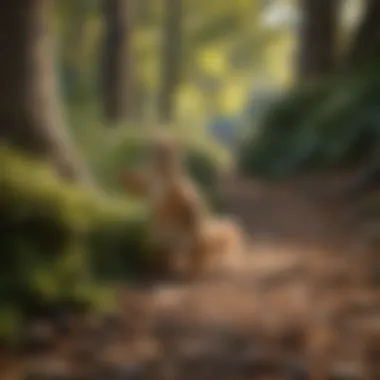
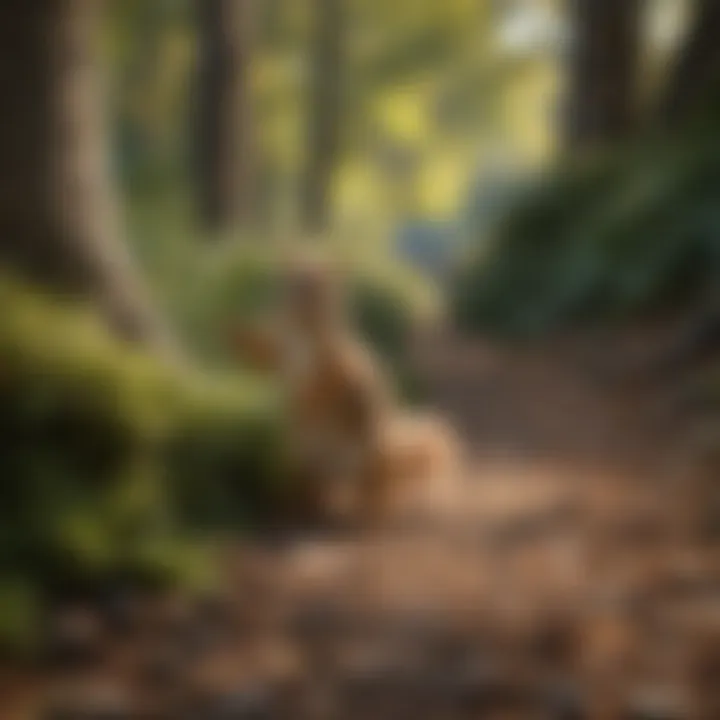
- Bird Feeders: If you have feeders, consider squirrel-proof options or placing them away from accessible spots.
- Garden Vegetables and Fruits: Planting squirrel-resistant plants and using barriers can restrict their dietary sources.
Home Range and Nesting
Squirrels establish a home range that can extend from a few hundred to several thousand square meters, depending on the species and food availability. They build nests, called dreys, in trees using leaves, twigs, and other materials.
It's essential to consider the proximity of potential nesting sites when planning deterrent strategies. Ensuring that tree branches do not overhang buildings or gardens can reduce access. In addition, limiting dense shrubbery can deter nesting in unwanted areas.
"The presence of squirrels in your yard often indicates accessible food and nesting opportunities."
By understanding their behavior, feeding habits, and nesting tendencies, homeowners can create a less inviting environment for squirrels. This knowledge is fundamental in forming a strategic approach to protecting gardens and landscaping.
Identifying Squirrel Damage
Recognizing squirrel damage is crucial for homeowners who want to protect their gardens and landscapes. By identifying signs of infestation and the types of damage that squirrels can cause, you can implement more effective deterrent strategies. Awareness of these factors allows you to act promptly and minimize any impact on your property. Furthermore, understanding the extent of squirrel damage can help you evaluate the effectiveness of your current measures and adapt your approach accordingly.
Signs of Infestation
Identifying signs of a squirrel infestation is the first step in addressing the problem effectively. Some noticeable indicators include:
- Visible Damage to Plants: Squirrels often gnaw on stems, leaves, and fruits, leaving behind noticeable bite marks.
- Nesting Signs: Look for nests made of twigs and leaves in trees or attics. Squirrels typically use tree cavities or build nests in high places.
- Droppings: Squirrel feces resemble small black pellets and can often be found near feeding sites or nesting areas.
- Tracks and Trails: Observe for footprints, particularly in damp soil or snow, which can help confirm their presence.
Each of these signs can provide insights into the squirrel’s activity level and areas of focus in your yard. Early detection can significantly enhance your ability to manage the issue before it escalates.
Common Types of Damage
Squirrels can inflict various types of damage to your yard, and recognizing these can help you protect your plants and property. Common damage types include:
- Chewing on Hardware: Squirrels have been known to chew on wiring, insulation, and wooden structures, causing potential hazards and repair needs.
- Garden Damage: They dig up bulbs and seedlings, particularly those of tulips and other spring flowers, disrupting growth and investment in your garden.
- Fruit and Nut Theft: Squirrels are often after the fruits or nuts of trees and shrubs, leading to significant losses for gardeners.
- Tree Bark Damage: They strip bark from trees, which can expose the tree to diseases and pests.
Recognizing these specific forms of damage can assist in developing targeted strategies to deter squirrels effectively. By addressing the issue quickly and thoroughly, homeowners can safeguard their outdoor spaces and investments.
Deterrent Strategies
Deterring squirrels from your yard requires a multi-faceted approach that combines physical barriers, repellents, and habitat modifications. Each of these strategies plays a key role in preventing these agile creatures from invading your outdoor space. When applying these methods, it is crucial to consider their effectiveness, practicality, and overall impact on your garden and landscaping.
Physical Barriers
Creating physical barriers can effectively limit squirrel access to specific areas. Such measures include fencing options and netting for plants.
Fencing Options
Fencing options serve as a protective barrier for your yard, helping to block squirrels from entering. One of the key characteristics of fencing is that it can be tailored in height and material depending on the level of infestation in the area. A solid fence often proves to be a popular choice because it obstructs squirrels' vision and makes it hard for them to jump over. Many homeowners opt for tall mesh fencing which is affordable and effective.
However, a unique feature of fencing is its maintenance requirement; it can be subject to wear and tear from other elements, such as wind or seasonal changes. Therefore, constant inspections can be a necessity. Although sometimes costly, proper installation can yield long-term benefits against squirrel invasion, making it a strong strategy in this article.
Netting for Plants
Using netting for plants is another practical approach to deter squirrels. This method protects individual plants by physically preventing access. The key characteristic of this option lies in its lightweight and flexible nature, allowing it to cover a variety of plant sizes. Many gardening enthusiasts find netting an effective choice due to its simplicity and ease of use.
Netting’s unique advantage is that it can be adjusted as plants grow, ensuring continued protection without damaging plant health. One disadvantage, though, is that it may not be suitable for all plant species. Additionally, squirrels may sometimes find ways around netting, so it’s wise to combine this tactic with others.
Repellents
Repellents can offer an additional layer of defense against squirrels, acting as a deterrent scent to keep them at bay. They can be categorized into chemical and natural options.
Chemical Repellents
Chemical repellents play an important role in this strategy by infusing a strong scent that squirrels find unpleasant. One key characteristic of chemical repellents is their immediate effect. The common usage of products such as squirrel repellents made from capsaicin is prevalent among homeowners as they are marketed to deter pests effectively.
These repellents often have the ability to coat plants and areas where squirrels are likely to visit, making it a favored choice in maintaining gardens. Still, potential disadvantages include the need for regular reapplication and the possible negative effects on beneficial insects. Therefore, it is crucial to evaluate the situation and apply them judiciously.
Natural Repellents
Natural repellents, such as garlic or peppermint mix, have gained popularity due to their eco-friendly attributes. These options are simple to apply and are generally safe for gardens and localized wildlife. One of the main advantages of natural repellents is their pleasant scent for humans, even if it is displeasing to squirrels. They often have fewer side effects on the environment compared to their chemical counterparts.
Nonetheless, natural repellents may require more frequent applications than chemical ones, especially after rainfall. Their effectiveness can also vary based on the individual squirrel's behavior, making them less reliable. Overall, incorporating natural repellents can be part of a well-rounded strategy.
Habitat Modification
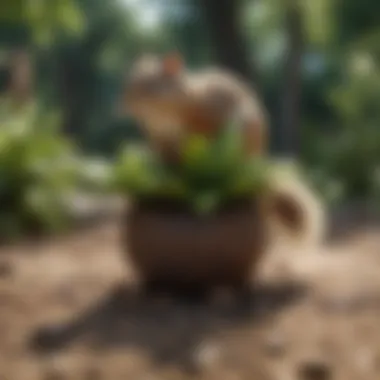
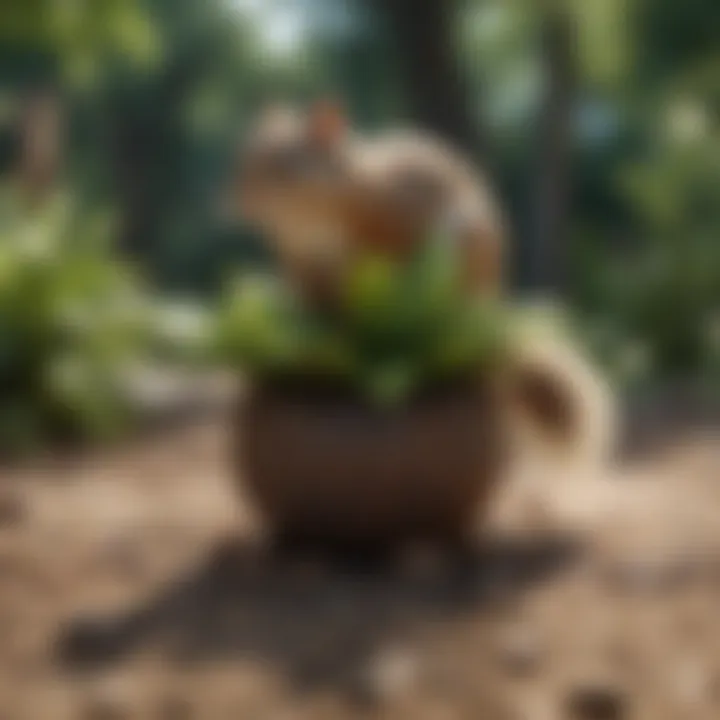
Habitat modification is about changing the yard's environment to make it less appealing to squirrels. This approach includes reducing food sources and creating obstacles.
Reducing Food Sources
Reducing food sources is an effective way to diminish the allure of your yard. One key aspect of this strategy is understanding what attracts squirrels. Bird feeders, unsecured pet food, or fallen fruit can invite these animals into your space. Thus, eliminating or securing these items is often considered a beneficial step in any squirrel deterrent plan.
By proactively managing food sources, you can greatly reduce the chances of attracting squirrels. This approach is economical as it does not require investment in products but instead leverages existing resources. The disadvantage here might be the constant vigilance required to ensure food sources are consistently managed.
Creating Obstacles
Creating obstacles in the yard is another innovative strategy that squirrels find challenging. This involves using landscape features such as rocks, raised beds, or even placing physical objects like garden decorations to deter squirrel movement. The main characteristic of this approach lies in its emphasis on modifying the environment for deterrence rather than using toxic methods.
However, the unique feature of creating obstacles is that it can change the yard's aesthetic. Homeowners can utilize attractive items while serving a dual purpose of deterring squirrels. Still, it needs regular check-ups to ensure that obstacles remain effective and do not inadvertently create hiding spots for squirrels.
Each of these deterrent strategies has its unique attributes. By combining them, you can create a robust defense against squirrels while maintaining the integrity of your garden.
Utilizing Noise and Motion Detectors
Utilizing noise and motion detectors can serve as an effective deterrent against squirrels in residential outdoor spaces. These devices create an unpredictable environment that can discourage these rodents from approaching and may prompt them to relocate to areas where they feel secure. The presence of sudden sounds or movement can disrupt their activities, making it less likely for them to invade your yard.
Types of Detectors
There are several types of noise and motion detectors available for homeowners. Each type serves a specific purpose and can be effective against squirrels:
- Ultrasonic Repellers: These emit high-frequency sounds that are unpleasant for squirrels but generally inaudible to humans. The constant, irritating noise can keep them at bay.
- Motion-Activated Sprinklers: These devices sense movement and spray water when a squirrel enters their range. The sudden burst of water can shock a squirrel, encouraging it to leave the area quickly.
- Sound Triggered Alarms: These alarms can be set to go off when motion is detected. The loud noise can startle squirrels and drive them away from your property.
When choosing a type of detector, consider the layout of your yard and the specific habits of the squirrels in your area. Each device works best in different settings and situations.
Installation and Placement
Proper installation and placement of noise and motion detectors are critical for their effectiveness. Here are key points to consider:
- Location: Position the detectors where squirrels frequently visit, like near gardens, bird feeders, or trees. This strategic placement increases the chance of detection.
- Height: If using motion detectors, consider the height at which they are installed. Most squirrels are agile climbers, so placing detectors a few feet above ground level can optimize their detection range.
- Visibility: Detectors should be placed discreetly within the landscape to avoid drawing attention from squirrels while still being effective. Incorporating them into existing plants or garden features can help conceal them.
- Battery and Maintenance: Ensure that devices are regularly checked for battery life and functionality. A device that is not operating effectively will provide no deterrent against squirrel presence.
Installing noise and motion detectors can require some trial and error. Evaluate their effectiveness regularly to make adjustments as needed. Keeping these factors in mind will enhance the overall success of your efforts to deter squirrels effectively.
Trapping and Relocation
Trapping and relocation represent a practical method for managing squirrel populations. This technique allows homeowners to physically remove squirrels from their yards without causing them harm. While some may view trapping as a last resort, it can be an effective approach, particularly when other deterrent strategies fail. Understanding the techniques and implications of trapping is essential for ensuring humane and environmentally responsible practices.
Overview of Trapping Techniques
Several trapping techniques exist, each with specific advantages. The most common type of trap used for squirrels is the live trap. These traps are designed to capture the animal without injuring it, allowing for safe relocation. Here are some popular options:
- Single-door traps: This design allows the squirrel to enter the trap from one side. Once inside, the door closes automatically.
- Two-door traps: These traps provide entry from both sides, creating a more inviting environment for the squirrel.
- Squirrel bait: Effective bait includes peanut butter, sunflower seeds, or corn, which can attract squirrels into the trap.
Generally, setting up traps at dawn and checking them frequently improves success rates. It is important to consider the traps' placement. Areas with visible squirrel activity, such as near trees or gardens, are ideal for placement.
Legal and Ethical Considerations
Understanding the legal and ethical dimensions of trapping squirrels is crucial for responsible animal management. Local regulations often dictate the use of traps, including which types are permitted and how caught animals should be handled. Here are some key points to consider:
- Check local laws: Before proceeding with trapping, familiarize yourself with local wildlife regulations. Some regions require permits for trapping certain species.
- Humane practices: Always use live traps that do not harm the animal. A well-aimed approach prioritizes the squirrel's well-being.
- Relocation Safely: If relocating squirrels, do so at least several miles away from your home to discourage their return. Choose natural areas away from urban settings to release them.
- Monitor the traps: Leaving trapped squirrels unattended for long periods can lead to stress or injury. Check traps regularly to ensure the animals' safety.
Overall, both trapping and relocation require careful planning and consideration. By adhering to local laws and utilizing humane methods, homeowners can manage squirrel populations effectively, balancing their gardens’ needs with wildlife welfare.
Maintaining the Deterrent Measures
Maintaining deterrent measures is crucial for ensuring long-term effectiveness against squirrels. It involves consistent vigilance and periodic updates to techniques used to discourage these persistent creatures. Squirrels are adaptable; thus, their response to deterrents can change over time. Proper maintenance not only helps in sustaining a squirrel-free environment but also enhances the overall health of your garden.
Regular Inspection
Regular inspection of the yard is an essential step in maintaining deterrent measures against squirrels. Conducting checks allows homeowners to assess the condition of barriers and assess whether any squirrel activity has resumed. Key points to consider during inspections include:
- Physical Barriers: Look for any damage or wear, particularly in fences and netting. Weather can cause wear and tear, leading to gaps that squirrels can exploit.
- Plant Health: Observe your plants for signs of squirrel damage. If plants are being chewed into, it may be an indicator that deterrents are not working as well.
- Squirrel Activity: Note any new signs of squirrel presence, such as nests or droppings.
Regular inspections not only reveal potential weaknesses in your deterrent strategy but also present opportunities to make timely adjustments.
Seasonal Adjustments
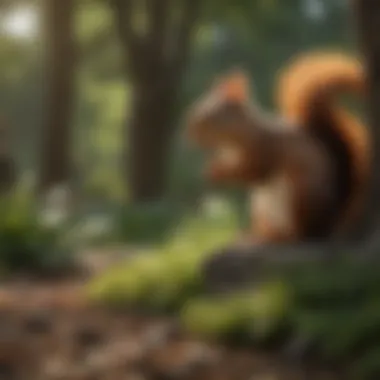
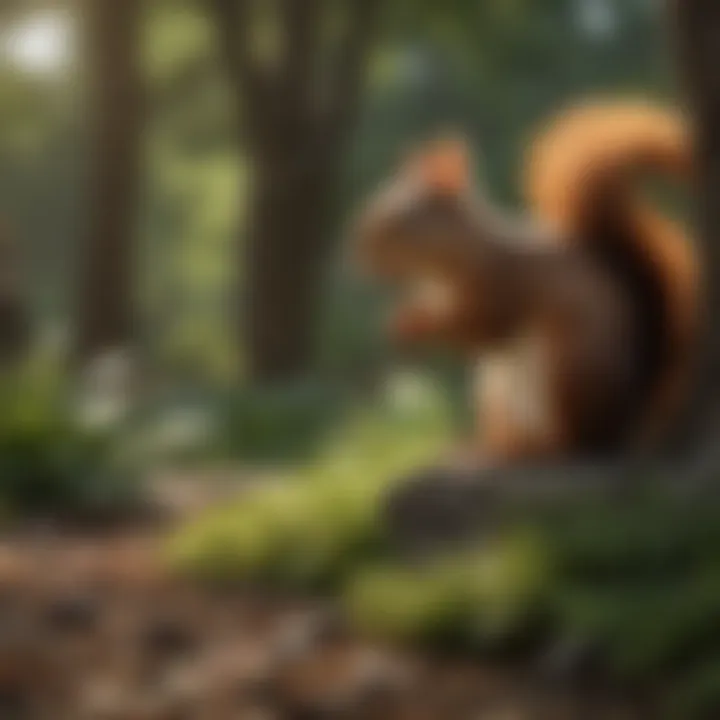
Squirrels exhibit different behaviors with the changing seasons. Therefore, seasonal adjustments are necessary to maintain the efficacy of your deterrent measures. Each season presents unique challenges and opportunities.
- Spring: As plants begin to grow, squirrels may become more active. Increasing barriers can be beneficial during this time. Consider adding more netting to protect new plant growth.
- Summer: During warmer months, food sources may become abundant. Review food waste around your property, and employ natural repellents like cayenne pepper as needed to deter squirrels attracted to your garden.
- Autumn: Squirrels gather food for winter. Consider planting squirrel-resistant species and implementing physical barriers that are particularly effective during this phase.
- Winter: Squirrels may still be present. Ensure that barriers are intact to prevent access to any stored food sources you may have.
Incorporating an approach that adjusts to seasons leads to finding the most effective way to keep squirrels deterred throughout the year. With focused inspections and seasonal strategies, you can create an environment that is less inviting to squirrels.
Alternative Approaches
To effectively deter squirrels, alternative approaches can provide unique strategies beyond standard methods. Homeowners often overlook less conventional tactics that can be highly effective when implemented correctly. Alternatives empower you to create an environment that is less hospitable to squirrels while promoting biodiversity.
Plant Selection
Choosing the right plants can naturally reduce squirrel presence in your yard. Squirrels are attracted to certain food sources, especially nuts and seeds. If these are abundant, it can draw more squirrels to your garden. Instead, consider incorporating plants that are less appealing to them, such as mature plants and herbs with strong scents like rosemary and mint.
Additionally, some plants can act as natural repellents. Plants such as marigolds not only enhance garden aesthetics but also deter various pests, including squirrels. Incorporating more native plants can also help create a balanced ecosystem that squirrels might find less attractive.
Key Benefits of Strategic Plant Selection:
- Reduces food sources for squirrels
- Creates a less inviting atmosphere
- Enhances the overall biodiversity of your garden
Encouraging Natural Predators
Incorporating natural predators into your yard’s ecosystem can serve as a highly effective deer deterrent strategy. Birds of prey, such as hawks, can help keep the squirrel population in check. To encourage these natural predators, you can install perches or nesting boxes in your yard. Having a raptor-friendly environment makes your space less appealing to squirrels, who instinctively avoid areas where they can be spotted.
Additionally, fostering a habitat that attracts cats might help reduce the squirrel population as well, since domestic cats are known for their hunting instincts. Providing shelter for these predators in the form of shrubs or cat condos can enhance their presence.
These alternative approaches not only address the issue but also contribute to a more vibrant garden that can flourish with more diverse plant life and wildlife activity.
Impact on Local Ecosystem
Understanding the various impacts of squirrel populations on local ecosystems is essential for homeowners considering methods to deter these animals. While squirrels can be considered pests by some due to their foraging habits, they also play significant roles in their environments. It's vital to assess these roles to achieve a balanced co-existence with wildlife.
Understanding the Role of Squirrels
Squirrels are not merely animals that invade gardens; they significantly contribute to the ecosystem's health. Their foraging behavior leads to seed dispersion, which is crucial for plant reproduction and biodiversity. When squirrels bury nuts, they often forget about some, allowing those seeds to germinate into new plants. This simple act supports the ecosystem's regeneration.
A diverse ecosystem is more resilient to disease and pests. By maintaining a healthy population of squirrels, you help sustain other species, from insects that assist in pollination to larger mammals that rely on a variety of plants for food.
For example, Eastern gray squirrels are known to aid in the growth of oak trees, positively impacting the entire habitat.
Balancing Ecosystem Needs
While it is necessary to mitigate squirrel access to gardens, it is equally important to recognize the ecological benefits they provide. Homeowners should strive to balance their desire for tidy landscaping with ecological stewardship. This can entail selective strategies rather than complete exclusion.
To balance these needs:
- Evaluate your garden layout. Consider including native plants that attract beneficial insects and birds, which can coexist alongside squirrel activities.
- Implement selective deterrence methods that allow squirrels to thrive without causing significant disruption to your garden.
- Promote natural predator habitats in your vicinity. Setting up birdhouses or brush piles can encourage hawks or owls, which can naturally regulate squirrel populations.
Maintaining a dialogue between the need for landscaping and the role of wildlife is essential. Thoughtful management often leads to a more sustainable environment while still protecting your yard. This approach requires patience and observation to find success in both gardening and wildlife conservation.
Closure and Best Practices
In addressing the challenges posed by squirrels in your yard, the Conclusion and Best Practices section provides a critical synthesis of the strategies discussed. Homeowners need a clear focus on methods that are both effective and respectful of local wildlife. By summarizing the key points throughout the article, this section emphasizes the importance of a multi-faceted approach.
Implementing useful deterrent measures not only safeguards plants and landscaping but also contributes to a balanced ecosystem. Approaches such as creating physical barriers, utilizing repellents, and modifying habitats have shown effectiveness. However, the true strength lies in their combination and adaptability based on specific yard conditions. This customization can lead to enhanced success in deterring these rodents.
In addition, the ongoing evaluation of these strategies holds significant weight. Without regular assessments, homeowners might miss emerging problems or shifts in squirrel behavior. Understanding this dynamism is vital. By cultivating an awareness of how different seasons affect squirrel activity, modifications can be tailored accordingly, ensuring the deterrents remain impactful.
Moreover, it is essential to engage in practices that maintain the physical aspects of the garden. Regularly inspect any barriers, replacing or repairing them as necessary. This diligence ensures a persistent defense against potential squirrel incursions.
"Homeowners should prioritize consistency in their approaches to deter squirrels, as changes in environment can influence animal behavior."
With these insights, the objective should pivot towards a focused application of diverse strategies, ensuring sustainability in both plant health and local wildlife relationships.
Summary of Effective Strategies
- Physical Barriers: Fencing and netting can offer immediate protection for gardens against squirrels. Stronger materials tend to yield better results, creating an unfriendly environment for invasion.
- Repellents: Options range from chemical to natural. Natural repellents like cayenne pepper can deter squirrel feeding but may need more frequent application.
- Habitat Modification: Reducing accessible food sources is often the most effective method. Keeping trash secured and harvesting ripe fruits promptly can limit squirrel attraction.
- Utilizing Technology: Noise and motion detectors also provide a non-invasive defense strategy that can disrupt their activity without the need for physical barriers.
- Regular Maintenance: Diligent inspections of barriers and plant health ensure a coherent effort in deterring squirrels effectively. Each season may require its own specific adjustments.
Future Considerations
As urban and suburban developments expand, the displacement of wildlife becomes ever more apparent. Future considerations must reflect this reality. Educating homeowners on wildlife tendencies fosters a community that is not only informed but also proactive in enhancing coexistence strategies.
Additionally, advancement in deterrent technology can play a significant role in this conversation. Research into environmentally friendly repellents and physical deterrents may yield innovative products that allow homeowners more options. Adopting sustainable practices in gardening can also become a prominent theme, encouraging a broader movement toward ecological responsibility.
Ultimately, addressing squirrel presence invites a reconsideration of how outdoor spaces are cultivated and maintained. Embracing these future facets will ensure that backyard ecosystems thrive while concurrently providing a peaceful and enjoyable space for homeowners.















